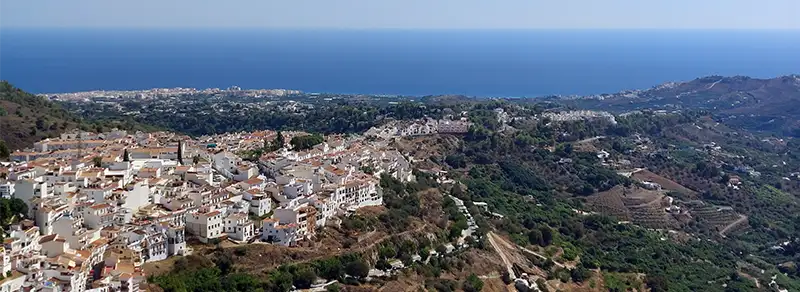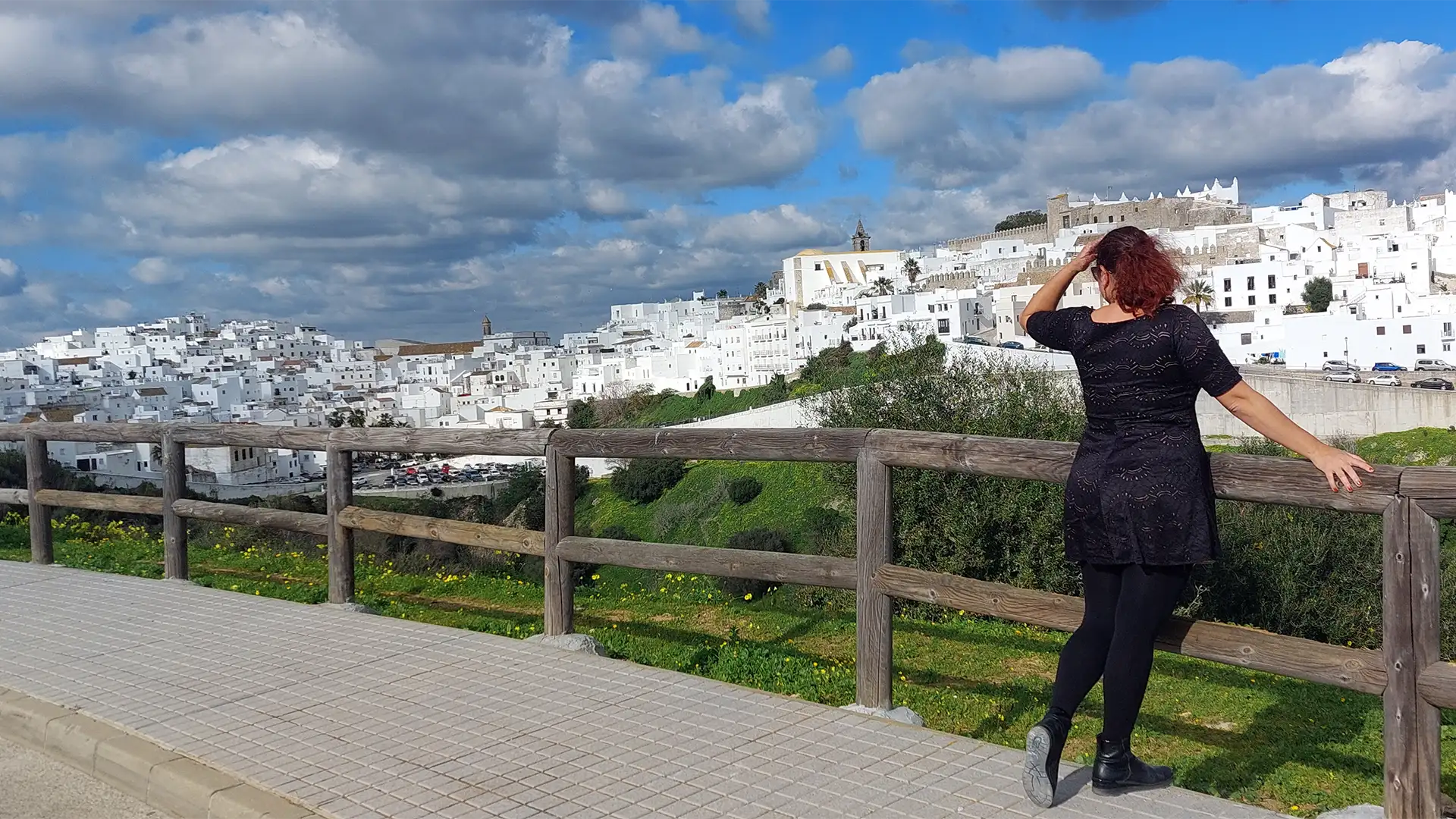When we think of Spain, images like these often come to mind: sun-drenched villages, colourful flowers cascading from balconies, and a pace of life that seems frozen in time. The Pueblos Blancos, or White Villages, are historic settlements in the south of the country, particularly in the Andalusia region. Known for their whitewashed houses and narrow, winding streets, they have come to represent one of the most iconic images of Spain.
Beyond their unmistakable charm, the White Villages are a living legacy of Moorish influence on the Iberian Peninsula. The tradition of painting houses white developed not only for practical reasons – to reflect the intense heat of the sun – but also due to cultural and architectural elements introduced by the Arabs who inhabited the region for centuries.

When is the best time to go?
The best time to visit the Pueblos Blancos depends on the kind of experience you’re after. Each season has its own appeal, and here’s what you can expect from each one:
Spring
(March to May)
The villages come alive with flowers adorning windows and balconies, creating a beautiful scene. The weather is mild (18°C to 25°C), ideal for wandering through narrow streets or hiking in the surrounding mountains. It’s the perfect season for those looking for vibrant landscapes and sunny days.
Summer
(June to August)
Despite the intense heat, this is the liveliest time of year, with traditional festivals, processions, and food fairs in many villages. If you enjoy experiencing local traditions, it’s worth planning your activities for early morning or late afternoon to avoid the hottest hours of the day.
Autumn
(September to October)
Golden tones take over the landscapes. Temperatures remain pleasant, perfect for long walks outdoors — but with fewer crowds, offering a more peaceful atmosphere. For those seeking charm and tranquillity, this is the ideal season.
Winter
(December to February)
With quieter streets and cooler weather, winter offers a more relaxed experience. It’s a great time to explore the villages without the usual bustle, though it’s worth noting that some attractions may have limited opening hours.
Whereare the White Villages located?
The White Villages are mainly found in the Andalusia region, in southern Spain. They are concentrated in the provinces of Cádiz and Málaga, although a few can also be found in nearby areas.
If you’re planning to base yourself in a larger city, Málaga and Cádiz are the best options, depending on which villages you’d like to visit. Málaga is ideal for reaching villages further inland, such as Ronda and Gaucín, while Cádiz is better suited for exploring those further south, like Vejer de la Frontera and Arcos de la Frontera.
On the map, blue markers indicate the villages that are easier to visit from Cádiz, while yellow markers show those that are more accessible from Málaga.
Getting around the white Villages
Exploring the white villages requires a bit of planning, especially if you’re aiming to visit more than one during your trip.
By car: the best option
Driving is by far the most convenient way to travel between villages. It gives you the freedom to go at your own pace, stop at scenic viewpoints and discover lesser-known villages. However, be prepared for narrow streets and limited parking in some areas.
Public transport
While there are bus services linking some of the larger villages, the frequency is often low and connections can be time-consuming. For smaller villages, public transport is often non-existent.
If you’re planning to explore the region using public buses, focus on villages with more daily connections, such as Ronda (from Málaga) and Arcos de la Frontera (from Cadiz). Most villages only have one or two departures per day, or even just a few per week. Unless you plan to spend the night in one of these places, it’s essential to pay close attention to timetables when planning your itinerary.
Organised tours
Another option is to join a guided day tour from cities like Seville or Málaga, which typically include visits to several white villages in one day.
Useful links: Buses
Make sure to check bus timetables in advance. As a general rule, services are limited, so it’s important to confirm what’s available before planning your route. Below are some helpful links to assist with your trip planning.
From Malaga
Frigiliana
Malaga-Nerja (Alsa)
Approximate duration: 1h30
Frequency: roughly every 30 minutes
Approximate cost: €5–6
Nerja-Frigiliana
Approximate duration: 15 minutes
Frequency: twice a day
Approximate cost: €1–2
Casares
Malaga-Estepona (Avanza)
Approximate duration: 1h30–2h
Frequency: around once an hour
Approximate cost: €10–13
Estepona-Casares
Approximate duration: 30 minutes
Frequency: twice a day
Approximate cost: €1.50–2
Ronda
Malaga-Ronda (Avanza)
Approximate duration: 2h30
Frequency: 3 times a day
Approximate cost: €11–15
Malaga-Ronda (Damas)
Approximate duration: 1h30–3h (depending on the number of stops)
Frequency: 7 times a day
Approximate cost: €11–15
Mijas Pueblo
Malaga-Mijas Pueblo (Avanza)
Approximate duration: 15 minutes
Frequency: 3 times a day
Approximate cost: €1–2
Canillas de Albaida
Malaga-Canillas de Albaida (Loymerbus)
Approximate duration: 1.5 to 2 hours
Frequency: 4 times a day from Monday to Friday, and 2 times a day on Saturdays and public holidays
Approximate cost: €10–13
Comares
Malaga-Comares (Alsa)
Approximate duration: 1 hour 45 minutes
Frequency: Twice a day from Monday to Friday
Approximate cost: €3–4
Setenil de las Bodegas
Malaga-Setenil de las Bodegas (Damas)
Approximate duration: 1 hour 30 minutes to 2 hours
Frequency: 5 times per week
Approximate cost: €12–15
From Cadiz
Cadiz-Setenil de las Bodegas (Comes)
Approximate duration: 3 hours 30 minutes
Frequency: 5 times per week
Approximate cost: €20–22
From Cadiz
Arcos de la Frontera
Cadiz-Arcos de la Frontera
Approximate duration: 1 hour
Frequency: 5 times per day
Approximate cost: €6
Bornos
Cadiz-Bornos (Comes)
Approximate duration: 1h30 – 2h
Frequency: 2 times per day from Monday to Friday, and once per day at weekends
Approximate cost: €9–10
Villamartin
Cadiz-Villamartin (Damas)
Approximate duration: 1h30 – 2h
Frequency: 3 times per day from Monday to Friday, and 2 times per day at weekends
Approximate cost: €9–10
Cadiz-Villamartin (Comes)
Approximate duration: 2h
Frequency: Once per day
Approximate cost: €10–13
Algodonales
Cadiz-Algodonales (Comes)
Approximate duration: 2h30
Frequency: Once per day
Approximate cost: €14–16
Olvera
Cadiz-Olvera (Comes)
Approximate duration: 3h–3h30
Frequency: 5 times per week
Approximate cost: €18–20
Torre-Alháquime
Cadiz-Torre-Alháquime (Comes)
Approximate duration: 3h–3h30
Frequency: 5 times per week
Approximate cost: €18–20
Alcalá del Valle
Cadiz-Alcalá del Vale (Comes)
Approximate duration: 3h40–4h
Frequency: 5 times per week
Approximate cost: €18–20
Prado del Rey
Saindo de Cádiz
Cádiz-Prado del Rey (Damas)
Duração aproximada: 2h
Frequência: 3x por dia de segunda a sexta e 2x por dia no fim de semana.
Custo aproximado: € 10-12
El Bosque
Cadiz-El Bosque (Damas)
Approximate duration: 2h15–2h30
Frequency: 3 times per day from Monday to Friday, and 2 times per day on weekends
Approximate cost: €10–12
Ubrique
Cádiz-Ubrique (Linha M-950)
Approximate duration: 2h30
Frequency: 3 times per day
Approximate cost: €10–15
Things to keep in mind to enhance your trip
Gastronomic Experience
The cuisine of the White Villages offers a delicious deep dive into Andalusian culture. Each village showcases its own typical dishes, such as traditional tapas, Payoyo cheese, and meals prepared with the region’s excellent olive oil.
Hiking and Outdoor Activities
This region is a paradise for nature lovers, with plenty of trails and outdoor pursuits. Walking, cycling and birdwatching are all popular, allowing visitors to enjoy stunning landscapes and the area’s rich biodiversity.
Cultural Events and Local Festivals
The White Villages are steeped in cultural traditions, with festivals taking place throughout the year. Spring fairs, religious processions and flamenco festivals are some of the highlights – fantastic opportunities to experience local traditions, complete with dancing, music and authentic celebrations.


